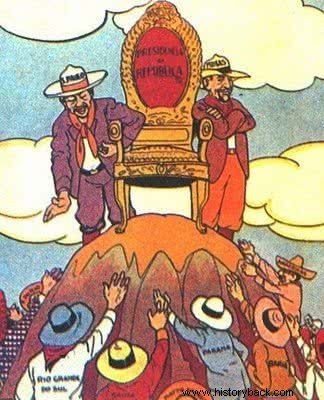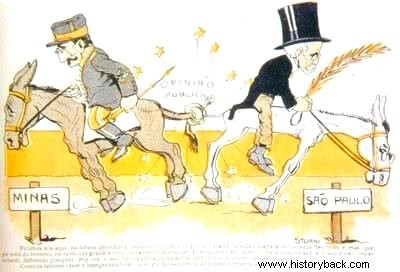The Oligarchic Republic (1894-1930) is characterized by the alternation of power between the coffee oligarchies of the states of Minas Gerais and São Paulo.
The presidents of this time were elected, in most cases, by the São Paulo Republican Party and the Mineiro Republican Party.
From the 1930s onwards, some historians call this phase the First Republic, the Republic of the Colonels or the Republic of Coffee with Milk, and even the Old Republic.

Cover of Careta Magazine, August 1925, nº809. The states try, but fail to achieve presidential power dominated by São Paulo and Minas Gerais. Author:Alfredo Storni.
Oligarchy
The word oligarchy comes from the Greek and means “rule by the few”. Thus, "oligarchy" designates a government that is dominated by a group of people or families that are united by the same economic activity or political party.
Oligarchies end up forming closed groups that reject any form of different thinking. In this way, even in democracy, it is possible to have cases of oligarchic governments.
Learn more about oligarchy.
Oligarchic Republic in Brazil
In Brazil, the period is identified when rural oligarchies dominated the Brazilian political scene.
Normally, the elected presidents were from the Partido Republicano Paulista (PRP), the Partido Republicano Mineiro (PRM). This practice was called the café-au-lait policy, alluding to the greater wealth generated by these two states.
The Rio-Grandense Republican Party (PRR) also played an important role at this time. This party sought to unbalance the balance between these two states, while defending the rural oligarchy and the gaucho urban classes.
It is important to note that, at that time, there were no national political parties as they currently do, but state parties.
The exception was the Conservative Republican Party (PRC) with supporters in Rio Grande do Sul and the northeastern states.
Despite not having managed to elect any president, this party had in the Rio Grande do Sul senator Pinheiro Machado its great representative in Brazilian politics.
The first civilian president elected, after Marechal Floriano Peixoto, was Prudente de Morais, supported by the São Paulo coffee oligarchy.
His term lasted from 1894 to 1898 when he was replaced by Campos Salles, also from São Paulo, from the Paulista Republican Party.
Characteristics of the Oligarchic Republic
Presidents-elect used their political influence to benefit coffee growers and ensure their stay in power.
In this way it was important to build state alliances such as the Governors' Policy and ensure the electoral result through fraud. This practice became known as the Halter Vow.
The local chiefs who carried out this practice were called colonels, despite not being linked to the Army. Thus, this policy of getting votes by force and exchanging favors is also called coronelismo.
Read more about coronelismo.
Protests
However, the Oligarchic Republic was not a peaceful period in the history of Brazil. Groups and parties outside the circle of power, such as urban classes, protested against the government.
We can cite as an example the Vaccine Revolt, the Contestado War or the Copacabana Fort Revolt.
Likewise, the growing Brazilian industrialization made businessmen and workers begin to demand more rights and space in national political life.
Workers fought for their rights through strikes and factory owners through business associations.

The interests of the Minas Gerais and São Paulo oligarchies did not always coincide. Author:Oswald Storni
End of the Oligarchic Republic
The period of the Oligarchic Republic ended when Getúlio Vargas, a candidate defeated in the 1930 elections, prevented the inauguration of Júlio Prestes.
With the Revolution of 1930, other social actors entered the Brazilian political scene, modifying certain forms of governing.
See also:First Republic